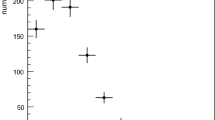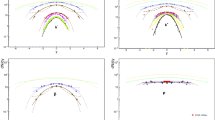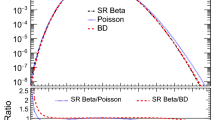Abstract
In this study, the charged particle multiplicity distribution produced in anti-neutrino interactions in nuclear emulsion is investigated in terms of the log-normal parametric model and KNO-G scaling for the first time. The results are based on the data collected by the CHORUS experiment in the \(\nu _{\mu }\) beam from CERN SPS. The analysis of 369 \(\bar{\nu }_{\mu }\)CC events showed that anti-neutrino charged-particle multiplicity data shape is well described by a log-normal distribution. Furthermore, KNO-G scaling has been successfully applied to the data and results confirm the validity of KNO-G scaling for the anti-neutrino interactions. Finally, results are presented in detail in the form of figures and tables.
Similar content being viewed by others
Avoid common mistakes on your manuscript.
1 Introduction
Charged particle multiplicity distributions provide quite important hints about the dynamics of the mechanism responsible for particle production. Particularly the shape of the multiplicity distribution is very useful to understand the correlation in the production of final state particles and energy. Up to now, numerous theoretical and experimental studies have been devoted to the subject, to explain the behavior of the multiplicity distributions. In these studies, various parameterizations and models have been tested and discussed in high-energy interactions in literature [1,2,3,4,5,6,7,8,9,10,11,12,13,14,15,16,17].
Among the parameterizations for the shape of the charged-particle multiplicity distributions, the Log-Normal Distribution (LND), which is a statistical distribution that has two parameters [18], is focused on in this study. In 1991, the ALEPH Collaboration showed that the charged particle multiplicity distribution of \(e^+\) \(e^-\) annihilation follows Log-Normal Distribution [19]. Then, the studies carried out for \(\nu \)p, \(\bar{\nu }\)p, and \(p\) \(\bar{p}\) interactions showed that LND is a good representation of charged particle multiplicity data [20,21,22,23]. In addition, a multiplicity study in hadron collisions showed that LND provides a good fit even at high energies, whereas other parametric models fail. Thus, LND provides a good description of data as well as can be applied in a very wide energy range [24].
The Log-Normal Distribution is defined as a form;
and m, s are the free parameters of the distribution.
Besides to the parametric model approach, the scaling properties of charged-particle multiplicity distributions are also widely studied. This technique allows combining the distributions of the multiplicity data of various energies in the same framework. The first studies on scaling analysis of multiplicity distributions were made about 50 years ago by Koba, Nielsen, and Olesen named KNO Scaling [25]. According to KNO scaling, multiplicity distributions obtained at different energies can be expressed with a single energy-independent scaling function. At very high energies, the probability of producing n particles P(n), exhibit a scaling law of the form
The scanning variable \(z= {n}/{\langle n\rangle }\) must satisfy two normalized conditions.
The studies on KNO scaling have shown some experimental results to be consistent, while others have reported violations. This is because KNO scaling is not self-consistent and is valid at finite energies [26, 27]. The problem was noticed by Golokhvastov and was overcome by his rearrangement of the KNO scaling function [28]. After his arrangement, the new scaling function, called KNO-G, given in the form( see Ref. [29])
With this modification, KNO scaling becomes self-consistent for all energies. Afterward the experimental works on \(e^+\) \(e^-\) and pp confirmed the validity of the KNO-G scaling [30]. Recently, charged-particle multiplicity distributions of \(\nu _{\mu }\)CC interactions, obtained from the CHORUS and OPERA Collaborations experimental data, are compared and tested for KNO-G scaling and the validation for neutrino interactions is also reported [31].
In this paper, the \(\bar{\nu }_{\mu }\)CC multiplicity data taken by the CHORUS Collaboration at 27 GeV \(\nu _{\mu }\) beam from CERN SPS between 1994-1997 is presented. The data is analyzed in terms of the log-normal parametric model and KNO-G scaling for the first time. Since their applicability and success have been shown in many different interactions, the data for the anti-neutrino interactions are very rare. The results are presented with various graphs and tables which is very useful to understand the behavior of anti-neutrino interactions also to estimate the production models for the MC event generators of future experiments.
2 Experimental data
The CHORUS represents a milestone in terms of the technique, design, and technology used in the experiment. The detector was designed to search for \(\nu _{\mu } \rightarrow \nu _{\tau }\) oscillations in the appearance mode. To do this research, they used hybrid setups formed by emulsion as an active target and combined with several electronic detectors. Due to its high spatial and angular resolution, the nuclear emulsion technique has been effectively used in the detector. For the CHORUS detector, nuclear emulsions had a very important role in the design, in fact, the detector is quite specific in history in of emulsion films that are used. The nuclear emulsions having a surface of 36 \(\times \) 72 \(cm^{2}\) were formed by coating 350 \(\mu \)m thick nuclear emulsion layers on both sides of a 90 \(\mu \)m thick plastic base. Thanks to its sub-micron resolution, nuclear emulsion allows the three-dimensional reconstruction of the neutrino interaction vertex. The results obtained in the experiments with this powerful technique made significant contributions to the physics of neutrino oscillation, it also pioneered other experiments [5, 32]. In appearance mode to be able to observe the oscillation through the emulsion technique, Wide Band Neutrino Beam of SPS was used [33]. A summary of the experiments and data sample of this study is given in Table 1.
During the analysis, CHORUS has been located 150000 neutrino events. From this data set, a subsample of 581 anti-neutrino events was used for the multiplicity study. The square of the invariant mass of the hadronic system is selected as \(W^{2}>1GeV^{2}/c^{4}\) to filter the QE contribution in the data. After the selection, the data remaining 369 events obtained from the Ref. [5] with their reconstruction and location efficiency.
Multiplicity distribution of \(\bar{\nu }_{\mu }\)-nucleus in nuclear emulsion [5]
When reliable data for high energy interactions became available over a wide range of energies, the importance of multiplicity distributions are improved. Since multiplicity distributions reflect the dynamics of interactions it has been studied with different beams and on different interactions. However, the multiplicity distributions of anti-neutrino interactions in nuclear emulsion only published by the CHORUS Collaboration which is a very valuable data in the literature. So the available charged-particle multiplicity distributions of \(\bar{\nu }_{\mu }\)CC interactions in nuclear emulsion are shown in Fig. 1 obtaining directly from the Ref. [5].
3 Log-normal distribution and KNO-G scaling
The Log-Normal is one of the well-known parameterization for charged-particle multiplicity distributions. Since the shape of charged multiplicity distributions is showed well described by LND, the fit function is applied to the corrected \(\bar{\nu }_{\mu }\)CC multiplicity data directly until the best fit was achieved, and resulting fit is shown in Fig. 2. The agreement fit line and data together with the parameters given in Table 2 indicate that LND provides a good description of the \(\bar{\nu }_{\mu }\)CC interactions as well.
In order to test KNO-G scaling in \(\bar{\nu }_{\mu }\)CC interactions, the sum \(\sum _{i=n}^{\infty }P_i\) versus n/\(\langle \tilde{n}\rangle \) is plotted. As it can be seen that in Fig. 3 all experimental data points lie on a single curve means that the data obey the scaling. The applied fit with equation (5) exactly follows the anti-neutrino data behavior. Previously, it has been described for the neutrino CC interactions [31] and a similar observation has been made by the anti-neutrino CC data in this work. Thus the resulting values of the parameters obtained from the fit function are also shown for comparison in Table 3.
4 Conclusion
The KNO-G scaling and log-normal distribution have proved their validity in many experiments and interactions to describe the multiplicity distributions. These results have sparked a curiosity about being tested in anti-neutrino interactions as well since the data has not been tested yet. In this study, anti-neutrino multiplicity data of the CHORUS experiment are compared and analyzed for KNO-G scaling and log-normal distribution for the first time. The shape of anti-neutrino charged-particle multiplicity distributions are found to be well described by the log-normal distribution. The obtained parameters of the log-normal fit for the anti-neutrino interaction are presented along with the distribution. The experimental data set is also analyzed in terms of KNO-G scaling which is a powerful tool to predict multiplicity distributions. It is confirmed that the anti-neutrino charged particle multiplicity distributions obey KNO-G scaling as well. It should be noted that the fit function calculated and applied within the framework of KNO-G scaling, gave successful results for both neutrino and anti-neutrino interactions of the CHORUS experiment. The results are presented in detail in the tables with those obtained in other experiments for comparison.
Data Availability Statement
This manuscript has no associated data or the data will not be deposited. [Authors’ comment: The experimental dataset used in present analysis is obtained from the CHORUS Collaboration article [5]. ]
References
R.E. Ansorge et al., Z. Phys. C 43, 357 (1989)
PLUTO Collab., C. Berger et al., Phys. Lett. B 78, 176 (1978)
TASSO Collab., W. Brandelik et al., Phys. Lett. B 89, 418 (1980)
P. Allen et al., Nucl. Phys. B 181, 385 (1981)
CHORUS Collab., A. Kayis-Topaksu et al., Eur. Phys. J. C 51, 775 (2007)
OPERA Collab., N. Agafonova et al., Eur. Phys. J. C 78, 62 (2018)
Ç. Kamışcıoğlu, Turk. J. Phys. 44, 222 (2020)
P.K. MacKeown, A.W. Wolfendale, Proc. Phys. Soc. 89, 553 (1966)
G.J. Alner et al., Phys. Rep. 154, 247 (1987)
G.J. Alner et al., Phys. Rep. 160B, 193 (1985)
G.J. Alner et al., Phys. Rep. 160B, 199 (1985)
G.J. Alner et al., Phys. Rep. 167B, 476 (1986)
A. Giovannini, L. Van Hove, Z. Phys. C 30, 391 (1986)
C.K. Chew, Y.K. Lim, Phys. Lett. 163, 257 (1985)
J.F. Grosse-Oetringhaus, K. Reygers, J. Phys. G Nucl. Part. Phys. 37, 8 (2010)
M. Arneodo et al., Z. Phys. C Part. Fields 36, 512 (1987)
Ç. Kamışcıoğlu, Eur. Phys. J. Plus 136(9), 944 (2021)
G. Wrochna, Preprint Univ. of Warsaw, IFD/8/1990 (1990)
ALEPH Collab., P. Decamp et al., Phys. Lett. B 273, 181 (1991)
WA21 Collab., C.T. Jones et al., Z. Phys. C 54, 45 (1992)
R. Szwed, G. Wrochna, A.K. Wroblewski, Mod. Phys. Lett. A 6, 245 (1991)
ALEPH Collab., D. Buskulic et al., Z. Phys. C 69, 1 (1995)
OPAL Collab., P.D. Acton et al., Z. Phys. C 53, 539 (1992)
S. Carius, G. Ingelman, Phys. Lett. B. 252, 647 (1990)
F. Koba, H.B. Nielsen, P. Olesen, Nucl. Phys. B 40, 317 (1972)
E735 Collab., T. Alexopoulos et al., Phys. Lett. B 435, 3–4 (1998)
UA5 Collab., G.J. Alner et al., Phys. Lett. B 160, 199 (1985)
A.I. Golokhvastov, JINR E2, 87 (1989)
R. Szwed, G. Wrochna, Z. Phys. C 29, 225 (1985)
M. Gazdzicki, R. Szwed, G. Wrochna, K. Wroblewski, Mod. Phys. Lett. A 6, 11 (1991)
Ç. Kamışcıoğlu, Mod. Phys. Lett. A 36, 09 (2021)
CHORUS Collab., E. Eskut et al., Nucl. Instrum. Methods Phys. Res. A 401, 7 (1997)
Ç. Kamışcıoğlu, Int. J. Pure Appl. Sci. 6, 237 (2020)
Author information
Authors and Affiliations
Corresponding author
Rights and permissions
Open Access This article is licensed under a Creative Commons Attribution 4.0 International License, which permits use, sharing, adaptation, distribution and reproduction in any medium or format, as long as you give appropriate credit to the original author(s) and the source, provide a link to the Creative Commons licence, and indicate if changes were made. The images or other third party material in this article are included in the article’s Creative Commons licence, unless indicated otherwise in a credit line to the material. If material is not included in the article’s Creative Commons licence and your intended use is not permitted by statutory regulation or exceeds the permitted use, you will need to obtain permission directly from the copyright holder. To view a copy of this licence, visit http://creativecommons.org/licenses/by/4.0/.
Funded by SCOAP3
About this article
Cite this article
Kamışcıoğlu, Ç. Properties of charged particle multiplicities in anti-neutrino interactions of the CHORUS experiment. Eur. Phys. J. C 82, 129 (2022). https://doi.org/10.1140/epjc/s10052-022-10088-4
Received:
Accepted:
Published:
DOI: https://doi.org/10.1140/epjc/s10052-022-10088-4







